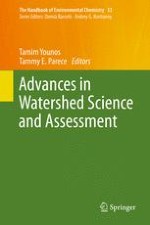2015 | OriginalPaper | Chapter
Microbial Source Tracking: Advances in Research and a Guide to Application
Authors : Brian Badgley, Charles Hagedorn
Published in: Advances in Watershed Science and Assessment
Publisher: Springer International Publishing
Activate our intelligent search to find suitable subject content or patents.
Select sections of text to find matching patents with Artificial Intelligence. powered by
Select sections of text to find additional relevant content using AI-assisted search. powered by
